Tour de Romandie: A story of redemption
From a sprinter finally claiming his prize at a climber's race to a GC win that wipes away the sting of a crash in sight of the line
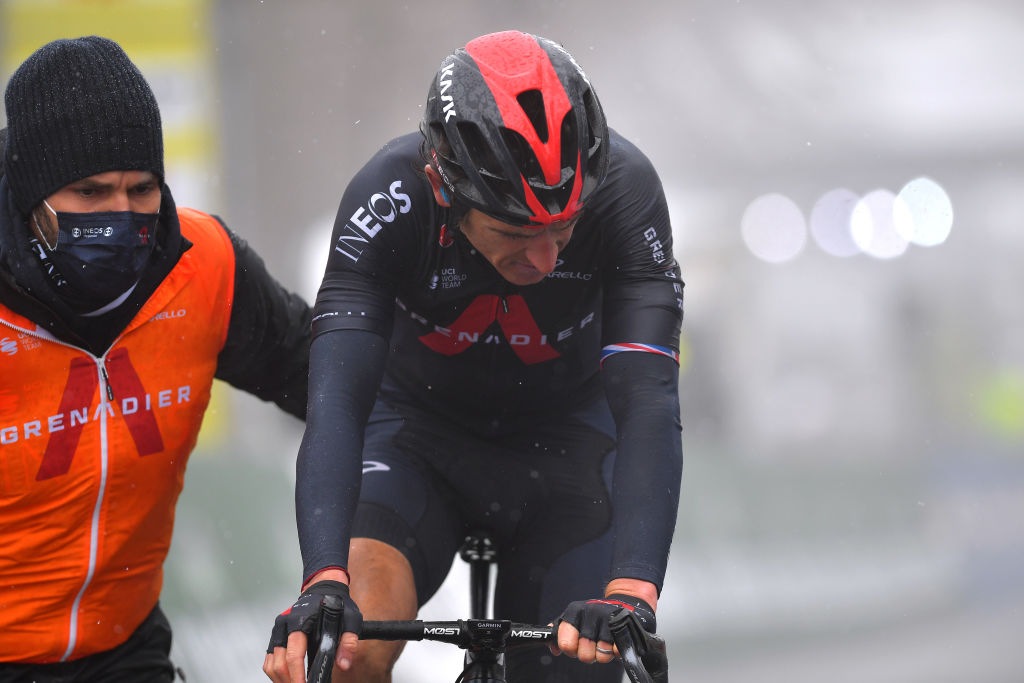
Like most works of literature, bicycle races have a central theme, a common thread weaving through kilometre after gruelling kilometre, tying everything together. Of these themes, a rather common one is that of redemption – from past mistakes, from embarrassment, from so-closes and near-misses, from the stranglehold of failure, from the high expectations of others, now fulfilled.
This quest for redemption, whether successful or not, will be the 2021 Tour de Romandie’s defining element, executed in some way during every stage of this race, a race which could be fairly described as one of the more difficult examples of its genre. We’ll get to that – the difficult stuff, of which there is plenty – soon enough. First, the introduction.
The Prologue
Prologues, like team time trials, are a dying breed in stage racing, having become increasingly few in number over the past ten years. Technically speaking, a prologue is a short time trial, usually under ten kilometres in length. Its purpose is, like the prologue in a book, expository. A prologue introduces the riders, lays bare their current form, and decides who gets to wear the leaders’ jersey on the first day of a stage race which has serious strategic implications for the participating teams.
One would imagine that the time trial specialists would excel at a prologue, however because a prologue is so short, any rider having a particularly good day can garner decent results. The Romandie prologue is no different. While there are three time trialists that make it to the top five – Rohan Dennis (Ineos Grenadiers), Rémi Cavagna (Deceuninck-QuickStep), and Stefan Bissegger (EF Education-Nippo), there are also some rather surprising showings of form, most notably that of Sepp Kuss (Jumbo Visma) whose time trial skills are middling at best, but who ended up thirteenth.
In four kilometres, anything can happen, and one thing the prologue excels at is revealing the weak. Stefan Küng (Groupama-FDJ), the European time trial champion, despite having just executed a blistering general classification win in the Volta a la Comunitat Valenciana, finishes no higher than fourteenth. Steven Kruijswijk (Team Jumbo Visma) who did reasonably well in the time trial at Itzulia Basque Country, crosses the finish line a disappointing thirty-third.
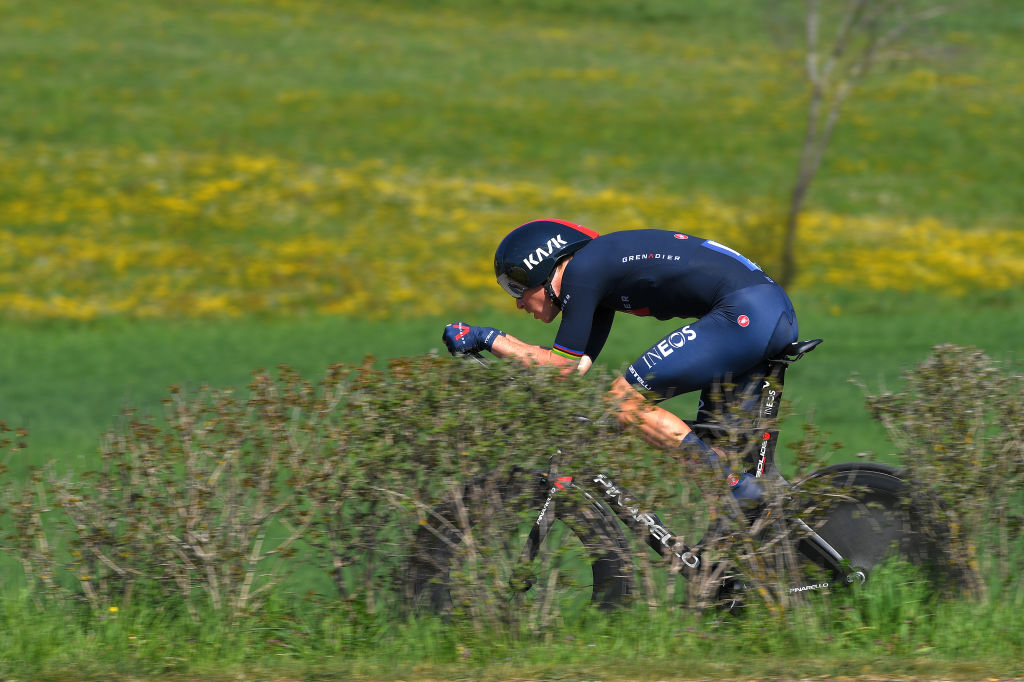
However, the biggest story from this introduction, the one that will set the course for the rest of the race, is who wins it. All three spots on the podium go to members of Ineos Grenadiers: Rohan Dennis, Geraint Thomas, and Richie Porte. The responsibility for taking control of the race now rests solely in their hands, and it’s a cause the team have always taken up with precise, competent, relentless gusto. Most recently that was on display in this year’s edition of the Volta a Catalunya, where Ineos Grenadiers riders, to put it bluntly, dominated. They claimed the entire GC podium by means of the sheer, indefatigable strength of their team day after day after day. Seeing the result of the prologue in Romandie, one expects a recreation of such a performance.
The mountains, however, have a way of making things terribly unpredictable and the Tour de Romandie is comprised almost entirely of mountains.
Get The Leadout Newsletter
The latest race content, interviews, features, reviews and expert buying guides, direct to your inbox!
Stage 1
The first stage is perhaps the easiest – one intended for the puncheurs and fast men – but it is by no means flat. After an introductory hill, the riders enter a circuit of the same two category three climbs – Produit and Chamoson – and repeat it three times, which is certainly enough to tire out the legs. The strategy most teams are likely to take is simple, on each climb thin out the herd. For both teams with or without a sprinter, distancing the stronger sprinters with every uptick in gradient gives each of their men a better shot at glory. There’s only one problem with that strategy: if no one is allowed to attack, if everything is shrewdly pulled back as soon as it pops off, the odds become more and more stacked towards a bunch or reduced bunch sprint.
As the riders reach the final 20 kilometres of the stage, two things are impenetrable in the lush valley of Martigny: the humidity and the vice grip Ineos Grenadiers has on the peloton. A light rain casts a fine mist across stretches of vineyards as the city meanders into view from behind a massive crag. Having just topped the final climb of the day, everyone in the peloton looks around, asks each other the essential question, who’s there?
Lost in the poor visibility, there seems to have been a split. The men at the front get the news that some of the stronger sprinters have been distanced, notably Jake Stewart (Groupama-FDJ) and Elia Viviani (Cofidis) – both favourites for this stage. Quick glances behind them and just around the bend, small flashes appear in the slipstream of one of the motorbikes. It’s a small group desperately trying to get back on. Stefan Küng swings to the side, looks for his teammate Stewart, sees that he’s one of the stragglers. More glances over hunched shoulders and it’s disorganised as they try to discern the statuses of one another.
Cavagna, in this moment, makes a decision. He puts in a dig, doesn’t want the likes of Viviani coming back. For once, his team, Deceuninck-QuickStep hasn’t brought one of their star sprinters to this race and one can understand why. Romandie is a climb-heavy parcours and a Sam Bennett or a Mark Cavendish would be more dead weight than help. To go early, 18.5 kilometres out, is perhaps to their strategic advantage here. It’s a massive attack, opening up a gap of eleven seconds in an instant. The sprinters’ teams are not happy with this – Cavagna’s a strong time trialist, certainly not one to let go so easily.
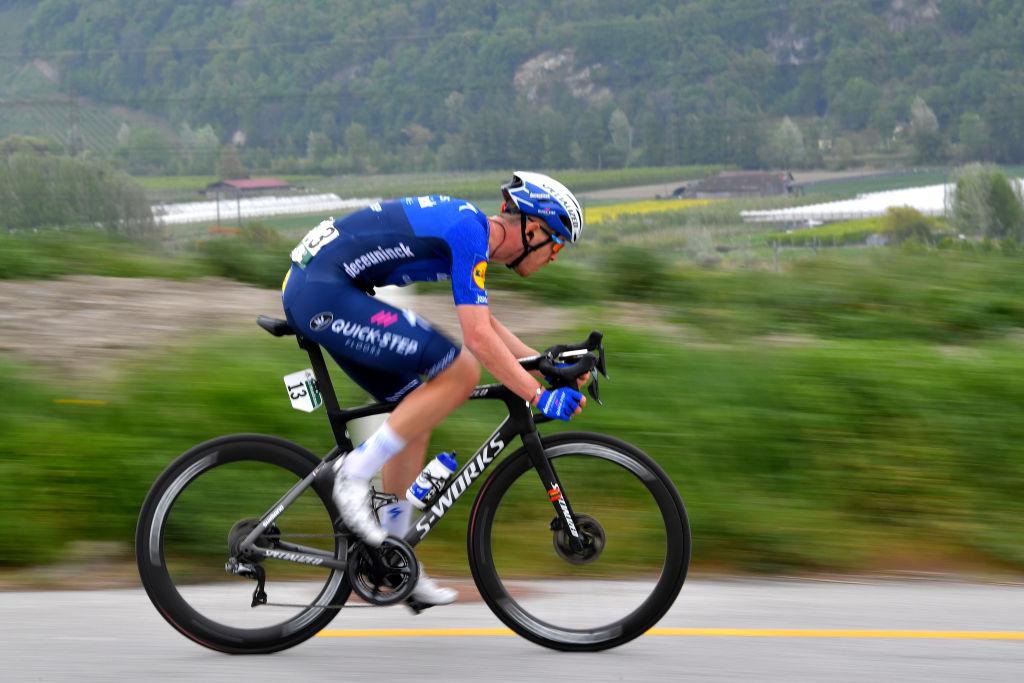
Bahrain Victorious, riding for their fast man Sonny Colbrelli, swerve out in front of the Ineos train to try and stitch things back up. Ineos is fine with this, they don’t want to see Cavagna let loose either, but also, this stage isn’t really for them to take, not having a sprinter of their own. This way they’re not responsible for doing the work. Thus, Cavagna is reclaimed by the peloton, and for a handful of uneasy kilometres, there is wary cooperation. The wariness allows Küng to retrieve Stewart, and the jersey of the Swiss national champion can be seen weaving around the right hand side of the bunch as the peloton enters a roundabout.
Thirteen kilometres to go, and Küng decides to push things a little harder as the pace begins to simmer down. It makes sense for riders like Küng and Cavagna, time trial men, to attack off the front. Think about it. Ineos is just going to keep the pace consistent, looking out for the interests of the yellow jersey – they know that the sprinters’ groups will be wary of one another, upping the tempo, taking the headwind, clawing things back. If they mark each other too much, Küng could potentially open up a gap of half a minute, one that would hold if the brinkmanship paralyses the peloton.
However, this is perhaps the one stage for the sprinters and their desire to win it is simply too strong. Küng is handily recaptured. There is 11 kilometres left and Cavagna has another go. His teammate Mattia Cattaneo follows, along with two unwanted passengers, Damien Howson (Team BikeExchange) and the local boy, Sebastien Reichenbach (Groupama-FDJ). Again, Bahrain Victorious chases, joined by Bora Hansgrohe, riding for Peter Sagan. Thirty seconds opens up between the front four and the peloton. This is getting dangerous. However, the front four stop cooperating, and in the headwind, combined with the work behind, their lead tumbles to a mere 12 seconds in less than a kilometre. After the quartet is brought back, the bunch resign themselves to the reality of a reduced sprint. For eight kilometres, it is feverish, the anxiety high.
In the wheel of his lead out men, Colbrelli thinks. He looks around, calculates his chances, fancies them decent. Viviani and unknown others are distanced. Stewart doesn’t appear to be in particularly good form, considering the fact that Küng was allowed to take his own chances in a solo move rather than save his energy to lead out his teammate. Who else is here? Dion Smith (Team BikeExchange), Magnus Cort (EF Education-Nippo), post-COVID-19 Sagan – not the stiffest competition Colbrelli’s had this year.
It’s been a frustrating time for the sprinter. He’s had three top ten finishes in the season so far. He knows he’s capable, that he’s got the legs to win, but it just hasn’t happened for him. His last victory took place in January of last year, where he claimed a stage of La Route d’Occitanie, a minor French stage race. Since then, Colbrelli’s been waiting, and as he looks around, watches teams exchange turns in the front, he musters up his strength, steels himself. With profiles that look like heartbeats, the rest of this race is not intended for men like him. This could be his only opportunity, the best one he’ll get for a while, ironically because this is not a race for the sprinters. Among the sprinters that are giving it a shot, he’s definitely one of the best.
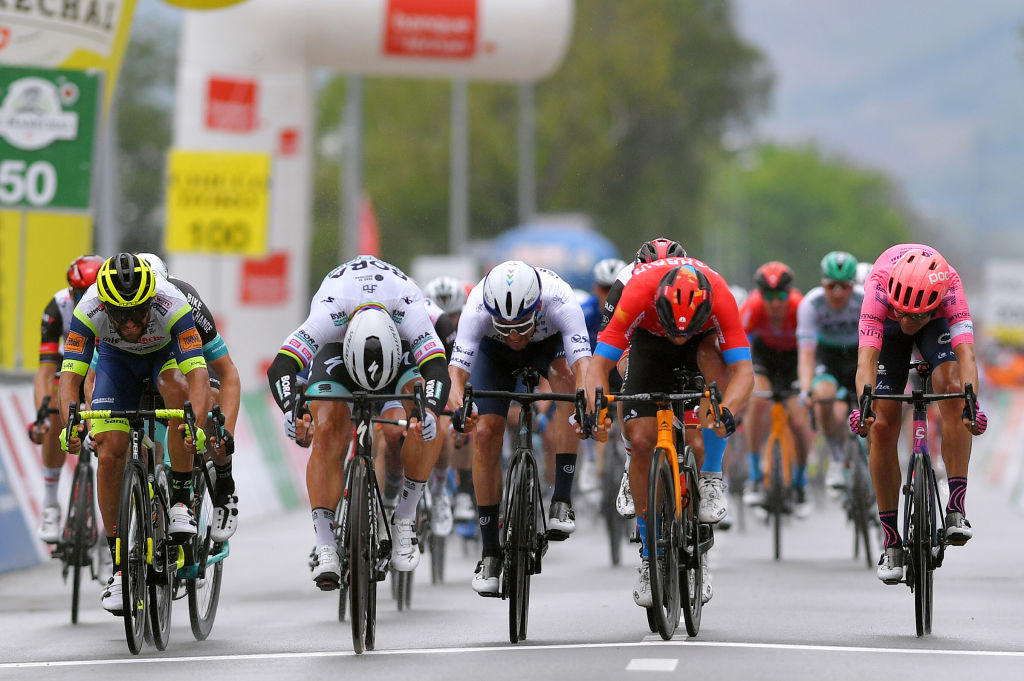
The peloton weaves through industrial backroads, slower than it usually is when approaching a reduced sprint but the headwind they’re facing would slow anyone down. Colbrelli watches Sagan, tracks him, for he’s still the biggest threat, COVID recovery or not. However, in the final kilometre, Colbrelli changes his mind. He wants to be in control. He snags the wheel of his lead out man at the front. Mads Würtz Schmidt (Israel Start-Up Nation) sits in third wheel, behind him, Sagan. Colbrelli knows he’s going to have to lead out the sprint but he trusts his legs, trusts his strength. Immediately Sagan follows. At 200 metres Colbrelli can see the line, he buries himself into his bike, closer and closer, Sagan on his right, matching each stroke of the pedal, an infuriatingly relaxed expression on his face. Down to 100 metres and Colbrelli can do no more, he has burned every reserve of energy he has, throws the bike across the paint as a last hurrah, but it’s not enough. Sagan snags the win by a fraction. For yet another day, Colbrelli remains a bridesmaid. He shakes his head, congratulates his colleague, and forces himself to think of tomorrow.
Stage 2
Stage 2 is not supposed to be relaxed, in fact, it’s supposed to be anything but. Its profile is mountainous. With four category two climbs topped off by a brutal category one kicker, the idea that such a stage could end in a bunch sprint is, well, laughable. It’s supposed to be a GC day. Time gaps are supposed to open up, attacks are supposed to fly off the front, split things, wreak havoc. But they don’t, they can’t, because Ineos Grenadiers will not let them.
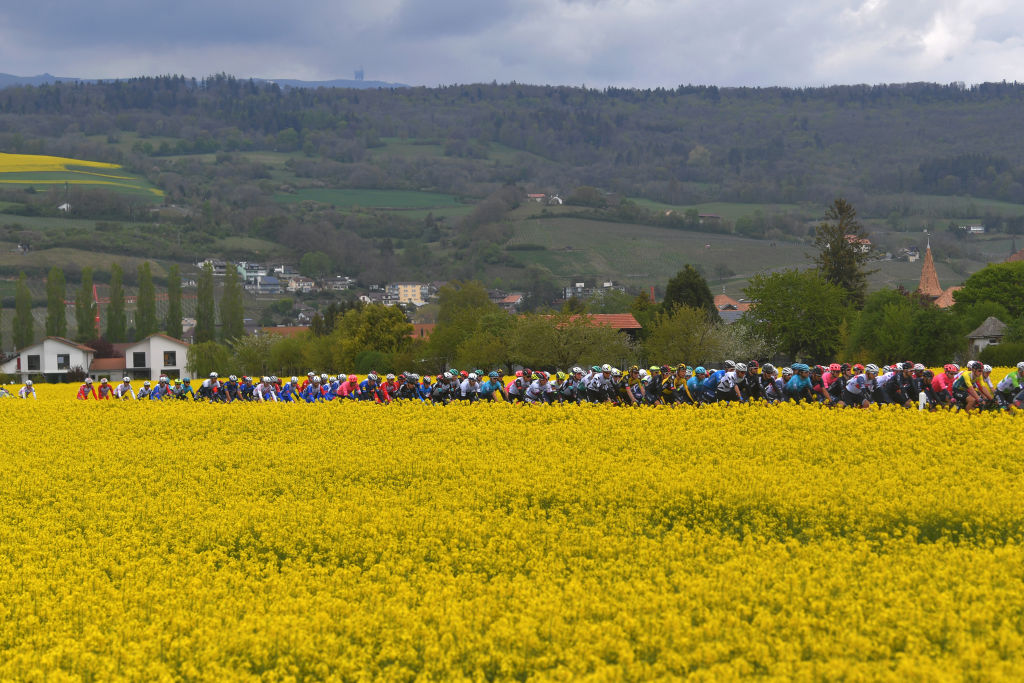
For most of the day, there is a breakaway, and some of the men in it are quite strong – Jonathan Caicedo (EF Education-Nippo), the Ecuadorean champion, Hermann Pernsteiner (Bahrain Victorious) – but the man who holds out until the final climb is Rein Taaramaë, the Estonian from Intermarché-Wanty-Gobert Matériaux, a previous winner of the Artic Race of Norway and the Tour of Slovenia in his glory days five or so years ago. The other men in the break, despite their strength, are lost to the whittling knife of the gradient. They stay out for so long, all the way into the last thirty kilometres, because no one in the bunch can get away, push the pace.
Ineos Grenadiers have a stranglehold on the race, keeping things at a somewhat leisurely tempo all day. It would be boring were it not for the tactical precision of their dominance, which in itself is admirable. Their team, quite simply, can afford to ride on the front for the duration of the race. To borrow a favourite metaphor I’ve used before to describe the Ineos strategy, they’ve brought a machine gun to a knife fight. When you’ve got the big engines of Filippo Ganna and Rohan Dennis and super-domestiques like Owain Doull, Eddie Dunbar, and Andrey Amador, you can afford to brute force stages like this. For the rest of the GC men in the peloton, the day’s final climb’s all they’ve got left. It’s their only chance to split open the minuscule seconds that separate the top ten.
At 24 kilometres to go the teams get in colour order as they approach La-Vue-des-Alpes, a 7.8 kilometre wall of a climb, whose average incline slows things to a crawl at 6.7 per cent. Taaramaë is swallowed up instantly. Ineos up the tempo and as soon as they do riders are spit out of the rear, domestiques who have done their jobs for the day, sprinters, including Sagan, that don’t feel like hanging on until the finish. With 20.3 kilometres to go Team DSM’s young Belgian talent, Ilan Van Wilder is the first one to make the move. Fausto Masnada, Deceuninck Quickstep’s GC man follows. The two have company: Michael Woods (Israel Start-Up Nation), Kuss, Reichenbach, Kenny Elissonde (Trek-Segafredo), and Ben O’Connor (AG2R Citroën). This sours the attack – two riders could tire themselves out with 20 kilometres left, but five? Now the group is immediately too strong, Ineos has to pull it back. Except there’s a dilemma as they’ve been controlling the pace all day and the trade-off for said control is that they’ve had to burn through men like matchsticks. Ganna drops back.
Soon, there’s only three men left, the podium boys from the prologue – Dennis, Thomas, Porte. Of the three, who do they sacrifice? Who closes this down? Dennis may be in the yellow jersey, but compared to two Tour de France podium winners, he’s not who Ineos is riding for. It’s a ruthless decision, and they make it shrewdly. Dennis’ time in the sun is up, and, as such, he heads up the chase, sacrificing himself for his leaders. Elissonde and Woods have another dig, Kuss following, but the peloton looms behind, but with the yellow jersey of Dennis now at the head of it, the attackers are swallowed back up. Dennis is booking it and in his fury, others are deterred from trying any funny business, just as Ineos planned and, just as Ineos planned, they reach the top of the climb without any further incidents. Easing onto the long descent only thirty riders remain.
One of them, rather miraculously, is Colbrelli.
Against all odds, it looks as though things are going to come down to a sprint, for Dennis’ domination at the front is ceaseless and no one can sneak by the likes of Thomas and Porte. Rolling hills flank the narrow road, peppered by the low-slung roofs of chalets. Who’s here, Colbrelli asks himself. Patrick Bevin (Israel Start-Up Nation) is near the front, he’s got some kick in him, isn’t far off from the GC lead, needs some bonus seconds. Plus there’s the trio from UAE Team Emirates of Diego Ulissi, Rui Costa and, of course, the Swiss Marc Hirschi, a talented puncheur who’d love to win on his home turf. The Ineos race leaders themselves, though unlikely to take the risk in a large sprint, are nothing to scoff at, either. This could be tricky.
Dennis is unrelenting in his control. If this comes down to a group finish, Ineos would be able to retain the leaders’ jersey but if someone like Bevin goes solo, it could put the hurt on the likes of Thomas and Porte. Hence, for now, it’s a waiting game, and Colbrelli is a patient man, waiting in the slipstreams of his three teammates, one of which takes over from Dennis with four kilometres left. Colbrelli might be the strongest sprinter of this group, but he’s the weakest climber, and today’s hills have put an ache in his legs. Even though his odds are decent, maybe even more so than yesterday, it’s still a gamble for him.
Dennis takes over again, accelerating as the peloton approaches the finish line, the city starting to rise up around them, signalling that the end is near, that they are growing closer to their point of arrival, and thus, of decision. Flamme rouge. The Bahrain Victorious sprint train moves up the side, Bevin in their wheel, Colbrelli behind Bevin. On the right, the trio from UAE – Hirschi, Costa, Ulissi. Bora’s Wilco Kelderman follows. Colbrelli’s lead out man starts the sprint, and he and Bevin trade places. It’s 500 metres, 300, 200. Colbrelli launches, but has he gone too soon again?
Bevin to the left of him, it’s neck and neck, Hirschi trying to wedge his way down the middle but his sprint’s been disrupted because UAE can’t choose which of their three men should go for the win. Colbrelli and Bevin head towards the banner and right now Colbrelli can’t look anywhere other than in front of him, can’t relinquish himself to even the very idea that loss is a possibility. It’s the final metres, and with a momentous surge, Colbrelli manages to sneak his wheel past the line first at the very last second, any closer and it’d be a photo finish. He raises his arms in the air, finally, after his long frustration, he is a winner, thus closing the book on his quest for redemption.
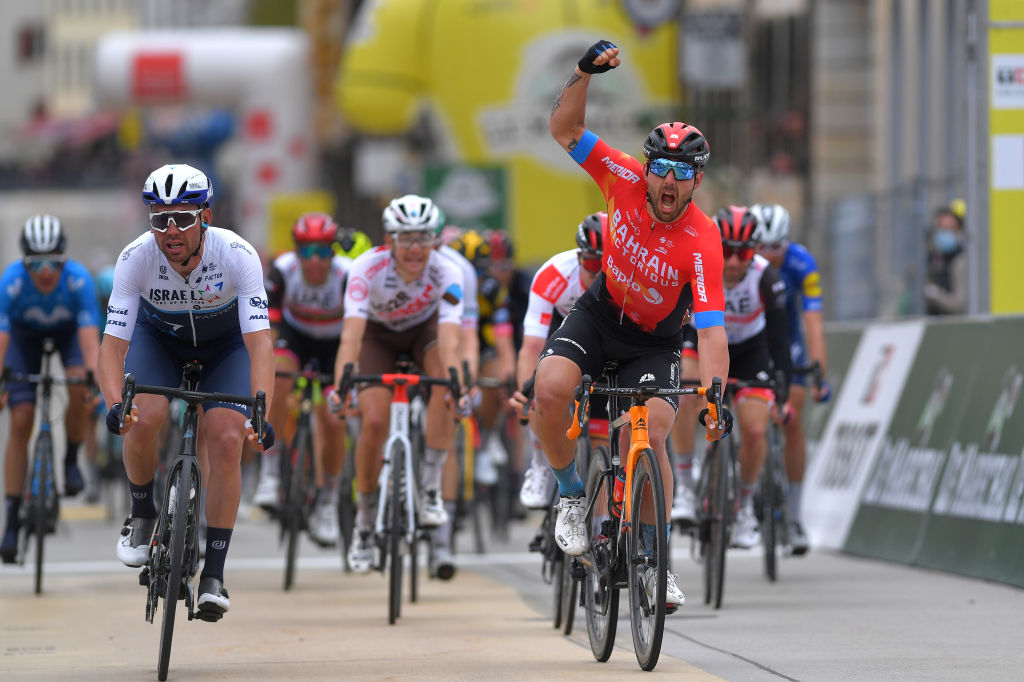
The rest of this race he will leave to his teammates, for Sonny Colbrelli’s work is done, his chest heaving with the effort, a big grin splitting his cheeks as the clouds converge and rain threatens to fall.
Tomorrow, it will.
Stage 3
Technically speaking, the third stage is easier than the second, featuring seven category three climbs, it’s a puncheur stage if there ever was one. However, today, it is raining, and not just raining, it’s pouring. There’s a reason the alpine valleys of Romandie are so green, after all. Rain is a great equaliser. It makes everything technical, reduces strong men to shivers, emboldens the weak and heightens the risk. In the rain, the breakaway of four maintains an advantage of over two minutes. With twenty-three kilometres left to go, that’s a decent gap, but still well within the range of being caught, on a normal day. In the rain, anything can happen.
The shearing sound of tyres on slick roads drowns out the commentators, and the visibility is near zero. Out at the front, the men ride quietly. Three of them are Swiss, for this is their home race and they want the attention: Johan Jacobs (Movistar), the time trialist Stefan Bissegger (EF Education-Nippo) and our beleaguered Küng. They’re joined by the young Belgian Kobe Goossens (Lotto-Soudal). Unfortunately, the quartet have been out all day in these miserable conditions and the chill and the wet surely must be taking a toll. Still, Küng flicks his elbows, urges his companions to keep on, for if they don’t, their collective efforts are doomed. Kilometres pass. They take turns, the little valley towns passing by in messy blurs. Küng is surrounded by youngsters here, and it’s clear he’s the one calling the shots. Jacobs and Goossens are neo-pros, both still looking for their first WorldTour wins. Bissegger is of time trial stock, he and Küng are cut from the same cloth. At the front, they trade places.
There’s another catch: tomorrow’s mountain stage, the queen stage, is under threat of cancellation due to inclement weather. This means that, for many of the riders, this could be the final stage of the race in which they can put in their bets for the GC before the decisive time trial. The resulting indecision changes the strategy and the stakes of the race considerably. The time gap to the break goes down beneath two minutes for the first time. Ineos, in Ineos fashion, rides at the front and as soon as they’re there, another 15 seconds is shaved off the lead. Küng, if he stays out, could move up a handful of positions and in a time trial, even if he’s a little off form, he’s formidable. He could end up in the top ten, and there’s good UCI points for that. He knows this is his chance, if he gives it his all and the possibility is there even if slim, if risky. If he fails, he’s done something, has told a story. Regardless of the outcome, Küng has to try.
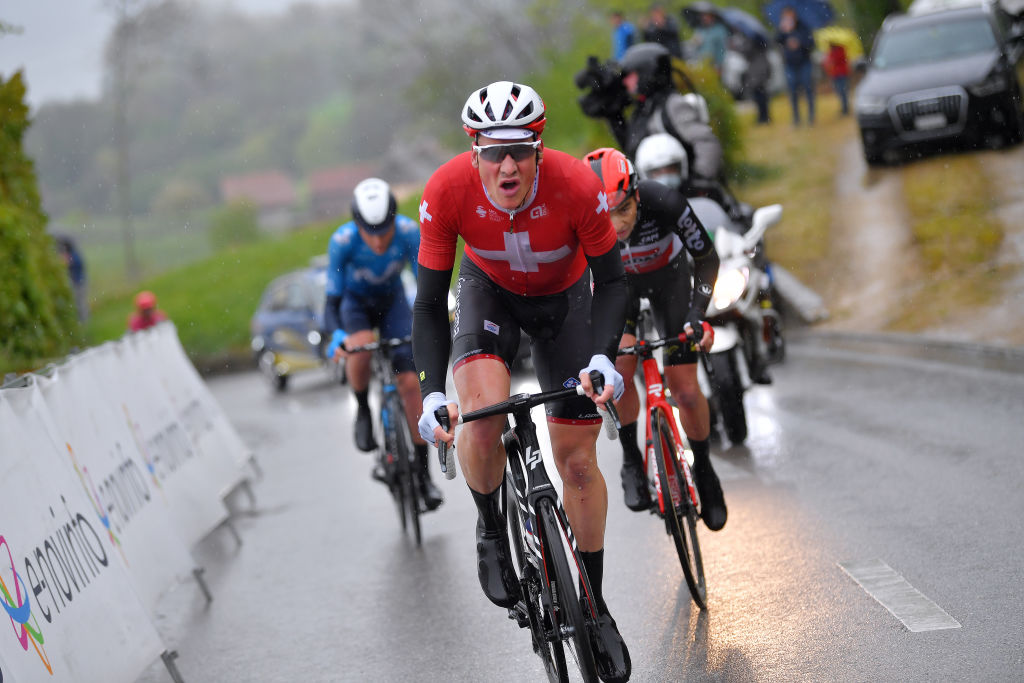
The men in front blink the rain from their eyes. The penultimate climb approaches. Küng encourages his companions once more for behind them the peloton is on a mission to bring them back. It’s under a minute now, the time gap. It’s 17 kilometres to go and the escapees hit the foot of Châbles. Küng accelerates right away, Jacobs and Goossens in his wheel. Bissegger, unfortunately, has given too much of himself already and he sinks like a stone, watches the reflection of the motorbikes and cars in the wet of the road as they pass him in loud rushes.
In the peloton the sprinter teams have faded, the GC men crowd the front and they can see the breakaway as they round a corner. Jacobs is the next to fade away, bike length by bike length. Goossens and Küng persevere, knowing that if they can crest the top of this hill ahead, they can take risks on the descent, risks the peloton cannot take, and thus pull the gap back out. Twenty one seconds. Again, behind them, it’s Dennis at the front, heading the charge, after all he’s the man with a big engine, the right man for the job. Küng’s not worried, though. He’s a master at this – he’s won from a breakaway in Romandie every time he’s attempted it. He’s sure he can go the distance but he just needs to hold on a little longer, needs to use the weather to his advantage. Goossens? Well, he simply knows that Küng’s a safe bet, a good man to follow. The duo manage to make it over the top without getting caught. The chase just got much harder for the peloton as now they’ll have to wait until the final climb to try again. For the two men out front, there’s a sliver of hope.
Cycling, as I’ve said many times before, is a cruel sport. It loves to raise the possibility of glory, nurture it, foster an attachment to a certain storybook outcome, only to brutally squash it, to squander all hope in an instant. Like massacring a butterfly with a flyswatter. At 14.6 kilometres to go Küng is that butterfly. He rounds a corner on the descent and then, in an instant, his wheel loses grip on the road’s white paint and he topples over, slides a rather impressive distance and slams into a (thankfully padded) sign before skidding another handful of metres. A look of shock is plastered across his face as he finally comes to a stop.
Just like that, it’s over for him. Adrenaline coursing through his veins, Küng gets to his feet, retrieves his bike and with his kit in tatters he hops back on, numbers flapping in the wind. He’s in no man’s land on the bike, the peloton in front of him, Jacobs in front of them chasing Goossens, who’s managed to make it out unscathed. Küng shakes his head but he continues on. If he can make it back to the bunch, at least he won’t lose too much time. There is 12.8 kilometres to go and Goossens is on the final climb, 33 seconds ahead of the yellow jersey. All Goossens has to do is survive the next 2,500 metres and then he can time trial his way to the end. However, it’s a gradient of almost eight per cent, maxing out at eleven, and after all that time braving the elements in the breakaway Goossens is tired. He’s lumbering through the winding vineyards at a steady, if slow tempo.
Meanwhile, behind, the first moves start to burst forward from the peloton. It’s Woods, Rusty Woods, trying yet again to initiate the moment of decision, just as he did yesterday, just as he will again tomorrow. Ion Izagirre (Astana-Premier Tech) is on his wheel, Kelderman trying to close, and he does – it’s back together. Küng manages to reach the bunch only to be spit out to the back of it. Up front, Goossens starts to dream of glory. More moves. Kuss, Jumbo Visma’s star climber. Surprisingly, Ineos is not in control, and Kuss is allowed to go clear.
Where are they? Something has happened. While the cameramen were documenting Goossens’s exploits, Dennis crashed. Porte and Thomas are falling back, waiting for him. For everyone else this is a big deal, this is their chance. It’s chaos.
Woods digs again. Marc Soler (Movistar) enters the mix. They slow, they watch each other, a game of brinkmanship, which should be good for Goossens right? The sole leader rounds a corner, and just as he does, in the corner of his eyes, he sees the bunch, there, all of a sudden. He’s slowed down too much, perhaps assumed his advantage was bigger than it was and, without the help of Küng, he languished, the biting sting of the rain chipping away at the last of his resolve. Masnada sees Goossens, and launches the final blow, behind him the colorful swarm unfurls, swallows the young rider up. So close, so it goes.
It’s back together. At this point, riders have heard the news that Dennis, wearer of the yellow jersey, has crashed. Just as soon as they hear it, Soler slams on the pedals, sees the writing on the wall – attack now when Ineos is distracted and the other teams will be too weak to follow – that, or they’ll mark themselves out of the race. His plan succeeds, he pulls out a gap, and the sole follower is Ion Izagirre, who’s quickly stranded in between Soler and the peloton as they enter the descent.
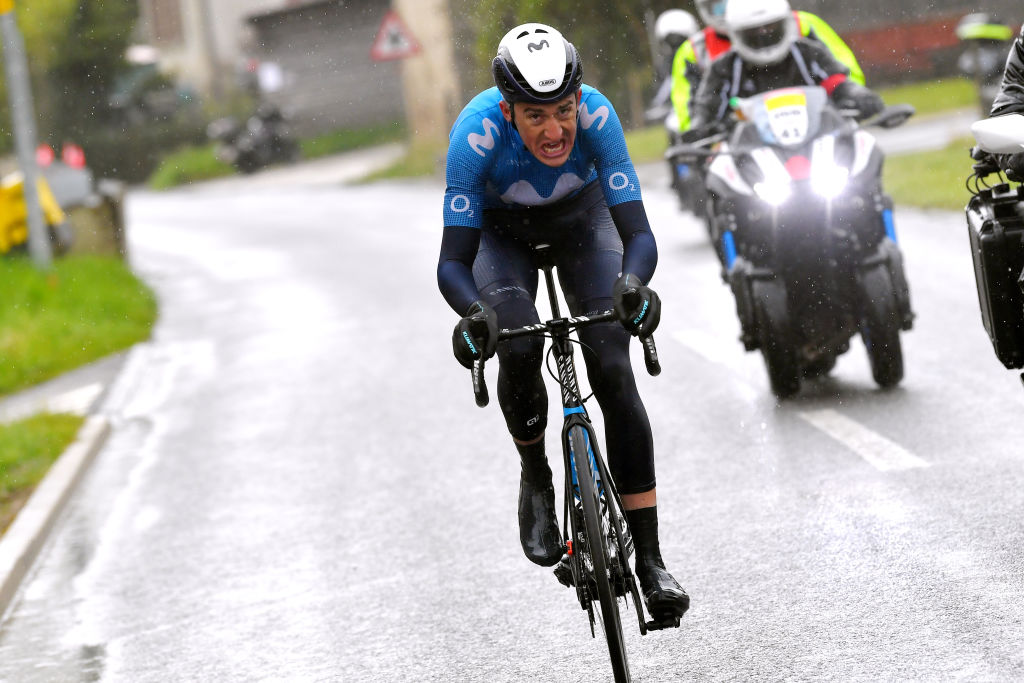
Soler is on a bit of a redemption arc of his own. He wants to show that he’s capable of doing great things, especially since the Giro d’Italia’s coming up next week. As he rounds a tricky corner, taking every risk in doing so, Soler’s simply trying to live up to the high expectations of others.
Ineos is pissed. They’re at the helm and in the final handful of kilometres, they rein in Izagirre. Soler’s in and out of the saddle, constantly looking behind. He knows full well he could get caught on the flat. It’s 21 seconds, six kilometres to go. Rain beats down on the Spaniard’s face, his tongue’s out, his head’s bobbing, ten seconds, he’s thinking, if I win this they’ll give me ten more seconds. That’s an eternity in races like this. Just 2000 metres and still 26 seconds. He’s giving everything. Flamme rouge. He has one mission: keep going and don’t slip up, which is normally a small ask but not on a day like today. After all, look at what happened to Küng. Soler shivers at the thought, grits his teeth, rounds the corner, the barriers flanking him.
Every second counts, he’s in a full on sprint, but the stage is his, easily. He only slows up to give a gesture to the camera as he crosses the line. He puts his index finger to his lips, in a shh motion, his way of saying to his critics, enough from you.
In the peloton, Sagan pips Magnus Cort at the line, the two fast men ensuring that no bonus seconds go to any of the GC men, much to their chagrin. Finally, as wheels skid to a halt, this miserable day out is over. Unfortunately for all of them there will be an even worse one tomorrow.
Stage 4
To borrow an oft-quoted aphorism attributed to Lenin, “There are decades where nothing happens; and there are weeks where decades happen.” In cycling, you can shorten the time span in the quote to fit a one week stage race, but the sentiment still stands. At the beginning of this race, it truly looked like it would, similar to the Volta a Catalunya, a week where nothing happens save for the total dominance of one team. However, in the span of the fourth stage, the queen stage, it’s as though an entire week happens all at once.
First off, the stage is brutal, there is no other way to describe it. Two category three climbs and two category one climbs define the parcours, but the worst, the most terrible, is the final climb, Thyon 2000, a climb twenty-one kilometres in length with an average kick of 7.6 per cent, not to mention the final haul, 3.4 kilometres at 9.4 per cent and then, 2500 metres at 10 per cent. For the riders, Thyon 2000 promises a seemingly endless expanse of unmitigated pain. Second of all, the weather conditions are even worse than they were yesterday. It’s raining, it’s freezing raining, it’s snowing, it’s foggy, the visibility is near zero, the peloton’s shrouded in total, eerie darkness.
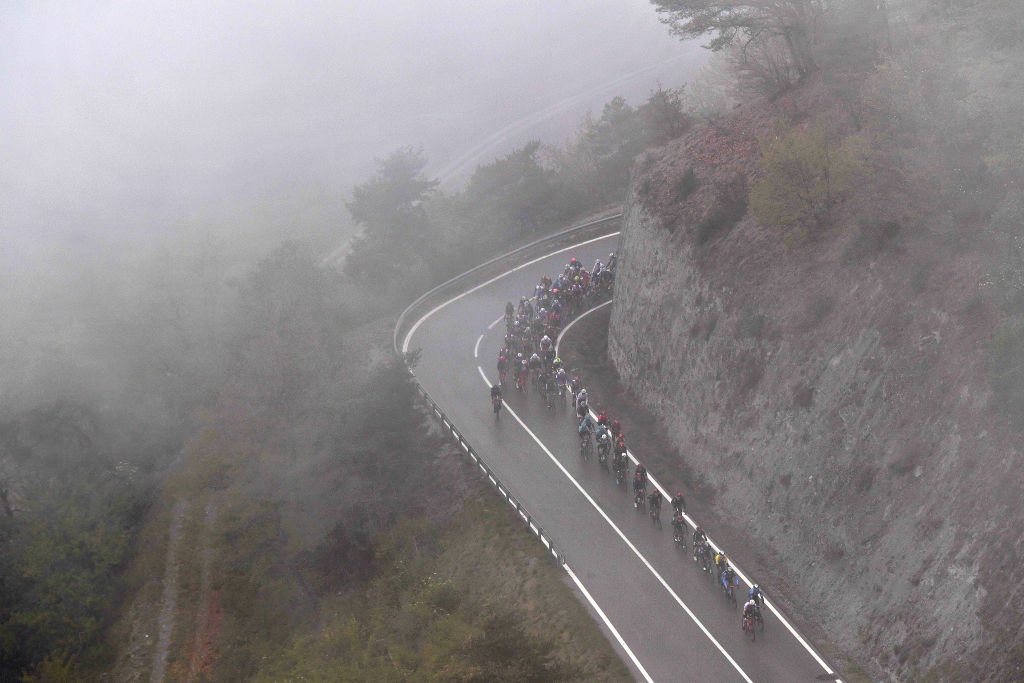
Here’s the situation: In the beginning, a breakaway of riders, including the likes of Goossens (again) and Cort manages to pull out a five minute gap, which, with 45 kilometres left to go, the peloton manages to claw back to under four minutes. To be honest, considering what lies ahead it looks like most breakaways look, doomed. There’s a catch, however. The race commissaires have decided at the last minute that the descent of this particular climb is too dangerous given the weather and so they decide to neutralise the race for three kilometres. Fine.
The problem is, the pace of the car that’s in charge of controlling the breakaway is quicker than that of the car patrolling the peloton. As a result, the time gap grows again with the peloton losing a minute in the neutralised zone and another after the cars move out of the way and they adjust to a new tempo. There is some discussion as to whether the time gaps will be readjusted by the race commissaires after the fact, but for now, they stand as they are. The race organisers have, in effect, given the breakaway an immense gift, if by accident. Suddenly, things don’t seem so doomed at the front after all.
Fast forward twenty kilometres. When the breakaway hits the base of the wretched Thyon 2000, they have a whopping 5:40 advantage. Five men remain in their ranks: Goossens, the sprinter Cort, Josef Černy (Deceuninck QuickStep), Simon Pellaud (Team Suisse), and Simone Petilli (Intermarché-Wanty-Gobert Matériaux). If they can continue to work together, their almost six-minute advantage can hold. However, there’s a problem. Ineos is at the front and when Ineos is at the front, that’s bad news for everyone else. Also, not to state the obvious, but Thyon 2000 is absolutely merciless and, after an already hilly day, there’s only so much even the strongest men can withstand.
Two kilometres into the Thyon’s 21, and Černy is the first to falter. In the next 1,000 metres, Goossens and Pellaud call it quits with the freezing temperatures and the chill of the wind finally getting to them. Soon, there are only two, Cort and Petilli. Petilli is a climber, but Cort? Let’s be real here; he’s a sprinter or a puncheur if you want to be particularly generous with the term. He could crack at any second. Yet, kilometre after kilometre, as the gradient makes a mess of their tendons and lungs, he stays on. Why? He’s one minute down on GC. If he can hold even that, he’s got a decent enough time trial to eke out the win, maybe. It’s a massive gamble. Still, for a sprinter to win a mountain stage, that’s news in and of itself. For ten kilometres, Cort perseveres at a steady pace, Petilli in dutiful attendance. In the freezing rain, on the dark slick roads of the empty mountain, the pair look lonely, helpless. They are. Hands numb atop their brake hoods, they continue, pedal stroke by pedal stroke. Theirs is a fight against exhaustion and time. On Thyon 2000, these are formidable enemies.
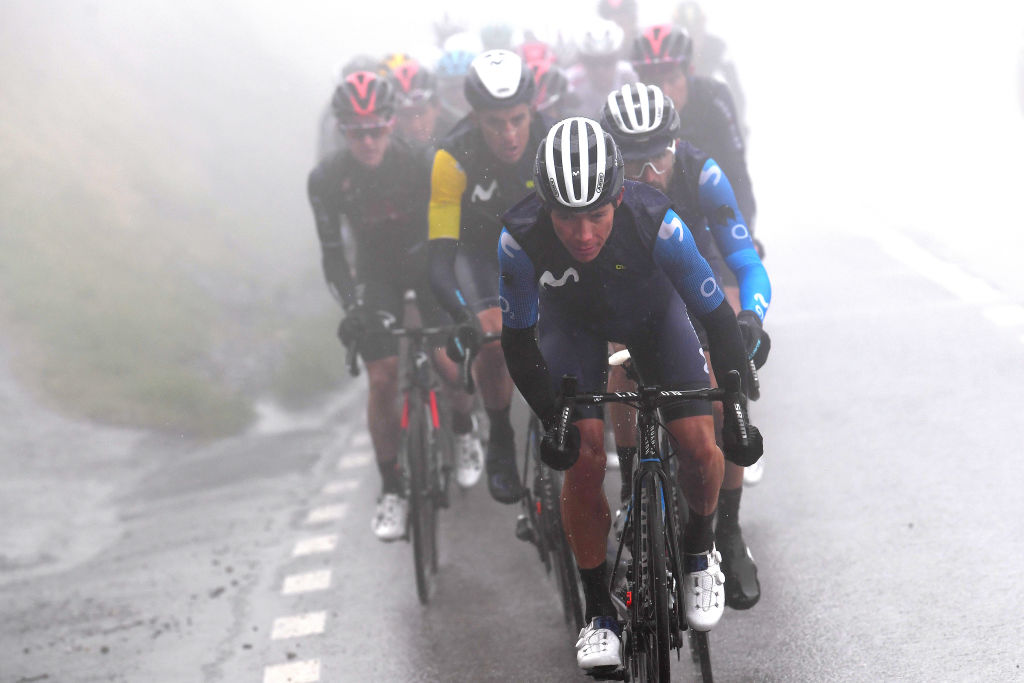
Meanwhile behind, it’s a numbers game. Soler, being in the yellow jersey, has the responsibility to ride at the front. Ineos, knowing that Soler is garbage in a time trial, is content to let his team ride, and so, Movistar pull the peloton switchback after switchback. It’s a little mean, to be honest. Movistar, however, doesn’t have the manpower to bring back the gap which is still hovering around five minutes. Enough of this, Ineos thinks. This is getting nervous, the climb’s almost halfway done. They take the helm with gusto. Immediately, favourites start to drop as Hirschi is claimed by his home roads.
There is 11.5 kilometres to go, they have reached the halfway point up front. Since Ineos took control, Cort and Petilli’s gap has shrunk to 4:35. Cort starts to panic. Behind, Soler starts to panic, too, for he’s only got one teammate left, Miguel Angel López. To add insult to injury, Ineos still has Dunbar and Dennis, a veritable engine room of power. At 9 kilometres to go Cort, in his panic, decides to get rid of Petilli. He attacks and Petilli just can’t go on anymore. Perhaps if Cort had forgone this little dig, things would have turned out differently but it’s unlikely. Fate is fate. The headlights of the car illuminate the slick road like watercolors. Yellow glow and green hills all mingle together in the dark reflections now being parted by slim road tyres. You can hear the slap of the rain. Fans, all bundled up on the side of the road, emerge from the impenetrable fog. Cort is soaked, he’s all alone with nothing but the mysterious winding asphalt before him. His gap since getting rid of Petilli shrinks another thirty seconds, 3:44. Dreaming becomes harder and harder for him and yet he dreams for that’s the only thing keeping him warm. Around him, rain turns into snow.
Soler, meanwhile, has been isolated. There’s nothing more López can do for him. Others drop, too: Costa, Kruijswijk. The Spaniard’s panic grows in his chest as he rides in the wheel of the Ineos Grenadiers. Only 8 kilometres remain, then 7 – he’s got to do something, he feels it, it’s his instinct. At 6.6 kilometres to go, his restlessness claims him. He attacks. It’s a rather suicidal move, baffling as there’s still so much climbing left, and Ineos has four men happy to take the wind and pull the gap back. Perhaps Soler lacks the confidence to go against the likes of Woods and Thomas in the final throes. Who knows? It’s an important move regardless. Woods, in pure Woods fashion, follows, stitches things back up. However, there is a casualty: Porte drops to the rear of the bunch, clings to it for dear life. It’s clear now that Thomas is Team Ineos’ chosen man. Cort’s down to three minutes, his advantage growing more and more precarious by the metre. The peloton has been thinned down to only 12 riders. Everything is starting to fray.
Dennis pushes things harder, bad news for Cort. They’re entering the worst part of the climb, and everything grinds to a halt. Under three minutes for our lone leader now, and it’s going down fast. At 4.8 kilometres BikeExchange’s Lucas Hamilton rides off the front of the bunch. It’s not so much an attack as it is a little surge, his legs spinning just that much faster. Hamilton’s ridden a quiet race, but he’s still only 35 seconds down on GC so the others will have no choice but to pursue. But who will? One has to ask how much longer Dennis can do this? He’s pulled his entire team day after day after day, a formidable task taken up gladly, and regardless of how this turns out he will have walked away from this race with his prologue victory. Right now, though, it’s cold, it’s wet, it’s steep, and snow sits in piles at the side of the road. Dennis shakes his head. This time, he can’t. He just can’t. It looks like Geraint Thomas will have to finish Thyon 2000 alone.
Dennis isn’t the only one who’s reached their limit. Cort, after a magnificent day in the breakaway, appears as though he’s about to collapse. He’s pedalling squares, his shoulders stiff from the cold. There’s nothing left in his stocky, compact sprinter’s body. He starts to weave. The fog adds a rather poetic cruelness for when Cort looks behind him, squints hard to see if he can make out any figures in the distance, he is answered only by the faint, murky glow of the motorbike’s headlights.
Hamilton has company. It’s Woods. Of course it’s Woods, it’s always Woods. O’Connor bridges, Masnada tries a few metres behind. These men know Thomas and Soler are isolated. They’re taking their chances. Woods digs. On a hill this steep, it’s all in slow motion. Kuss drops. Woods keeps digging. Cort is hurting, he’s in visual, visceral pain. At this point, he’s just trying to stay upright, tries to squeeze what he can out of one of his gel wrappers in a desperate bid for sustenance. His advantage is eviscerated. It’s only 20 seconds. Cort looks behind him and who does he see but Petilli, his erstwhile companion, lumbering to try and snag a merciful wheel. To add insult to injury, Petilli gets one over on Cort, a little bit of payback. He gives what’s left of himself in a knowingly futile attack and immediately Cort goes backwards, all morale, all hope in shambles. Woods catches both of them and Cort, our hero, fades backwards into the cloak of precipitation.
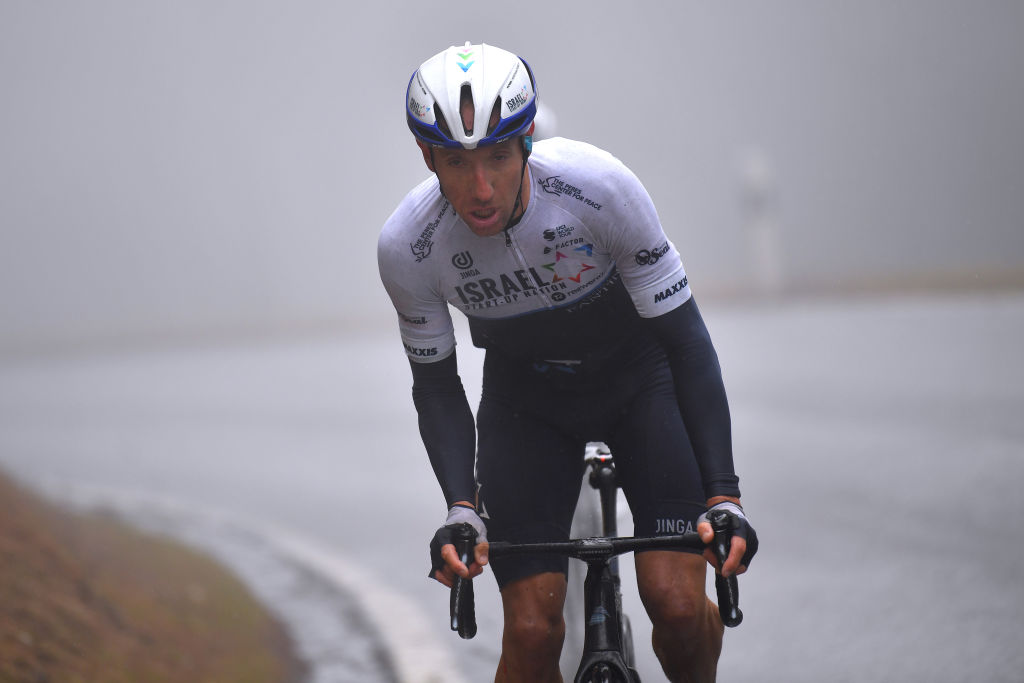
Meanwhile, Thomas has been patient. He’s been sitting in their little group, waiting for Porte to get back on, which he does. The Welshman’s lying low with Soler, biding his time, saving his energy. There’s a lot at stake for Geraint Thomas here as he hasn’t won anything since his 2018 Tour de France victory, where he also took the prize at Alpe d’Huez. It’s been a long dry spell, riddled with bad luck and injury but now is his chance to prove that he is worthy to contend another Tour de France later this year, perhaps one of his last. He grips his brake hoods, shakes the weariness from his shoulders. His time is coming, he can just feel it.
Woods heads the race, emerging from the mist. He’s got to claim as many seconds as he possibly can, because tomorrow is the time trial, and Michael Woods is not a time trialist in any sense of the word. He’s already lost a GC win at the hands of the race of truth in the opener of his season, the Tour du Var. If he wants to win this race, he’s got to do it from here, on Thyon 2000. A top ten finisher in both Liège-Bastogne-Liège and La Flèche Wallonne Woods is clearly in form but he still needs that extra edge, that extra bit of power to secure his place on the podium. He has it, that much is sure. Right now he’s making this awful, miserable climb look like a Saturday club ride.
Behind him, obscured by the fog, missed by the commentators, Thomas is following. He’s joined by Masnada and O’Connor, and the three of them work together to try and bridge to Woods. For Soler, who gave so much in yesterday’s gamble, the race is finished. Just like that, he’s somewhere lost on the mountain with Porte, almost a minute behind. At 2700 metres to go, Thomas decides Masnada and O’Connor are too slow. He rolls forward, attempts to catch a glimpse of Woods up ahead. Fourteen seconds separate them. His redemptive quest begins. There’s Woods, there he is, ah, yes, Thomas’ clever pacing has paid off nicely. Bad news for Woods, though. O’Connor drops Masnada, lurks in the shadows, always just a hundred metres behind. This trio pushes and pulls the time and the winner will be one of the three. Thomas takes the helm. It has been almost three years since he won a bike race, he thinks over and over again, and now he is 1000 metres from winning this one.
Snow pelts them, it’s piled up in huge drifts at the side of the road. It’s freezing, they’ve been out in the precipitation for hours with no respite, nothing to warm their hands or feet or quaking thighs. Even if Thomas doesn’t win the stage, it’s almost certain that he’ll be in the yellow jersey tomorrow and that’s enough to keep the warmth in him, or so it seems. Only 100 metres to go and after Woods’ effort, Thomas is clearly the stronger of the two because as Woods attacks, Thomas is there. They are side by side, together can see the banner and with it Thomas can see hope.
When he falls, it’s devastating.
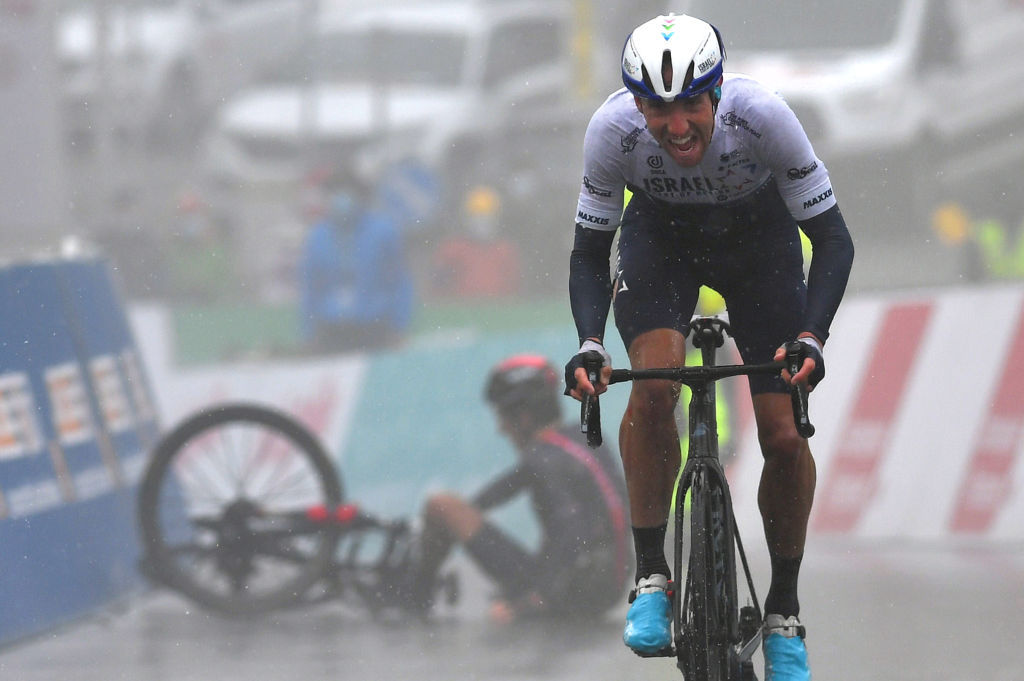
He reaches for the shifter but his hands are freezing and he has no grip. He’s throwing too much of himself into his uphill sprint, the wheel just slips and Geraint Thomas is on the ice cold ground fifty metres before the finish line, his hopes of a stage win extinguished just like that. Woods crosses victorious, and you have to feel for him, he’s deserved this just as much. Time ticks by. Thomas gets to his feet, slowly. O’Connor passes him for second. An Ineos soigneur pushes the stunned and injured man who barely manages to lumber to the line before the pursuers catch him. Snow falls around them, mixing with rain.
Michael Woods is the new leader of this race, but this race is far from over. Everything will be decided tomorrow, the fates of our characters now lie with the merciless second hand of the commissaire’s stopwatch.
Stage 5
Time trials have a way of tying things up, nice and neat in a little bow. In races like Tour de Romandie, where the time gaps between the top ten contenders are mere seconds, there’s the potential for major upsets, postponed to the very last day. Men who ride quieter races can slip by through seconds whereas those who excelled earlier, on the climbs, plummet in the ranks. As far as time trials go, this one’s miserable. It’s raining, again. There’s a cobbled climb of all things, no fun on a spindly, unstable time trial bike. After two mind-numbingly difficult days, every single rider is starting to feel exhaustion in their bones.
Still, our loose ends are sewn together nicely. In a little side story of redemption, Rémi Cavagna, the French national time trial champion, a man who has finished a frustrating second in every time trial he’s ridden this season, finally gets his day in the sun. He beats his equally youthful nemesis Stefan Bissegger by six seconds. Soler, who dropped to fourth yesterday, manages to hold on to fourth. Woods, our erstwhile leader, is claimed by the race of truth plummeting, sadly, to fifth. However, Fausto Masnad who, for the most part, has been lurking in the shadows, rides the best time trial he’s ever ridden in his career and manages to move up onto the podium. Perhaps the stakes were high enough for him to give more than usual. Whatever time Porte lost on Thyon 2000, he’s handily recovered on the time trial bike, as is expected. A dust of the hands, a third place in GC, done and done.
And then, there’s Thomas.
Injured, embarrassed, shaken, it remains to be seen if he can continue on. We know what a great time trialist he can be on a good day, but is it a good day? It’s raining again. His face is one of concentration, he rounds slick corners flanked by picturesque townscape, up the cobbles he goes, the jolts and bumps sending pain down his wrists and arms but it’s a brief pain, one he’s able to endure. Every time he crosses a line of paint in the road one has to hold one’s breath. At the intermediate time gap, he’s up on Cavagna, and for a little bit, it looks as though Cavagna is about to spend another day in his cursed second place. However, Thomas, in the shadow of yesterday, takes no risks. On the descent, he is nervous, trusts himself to have made up enough to take over the lead from Woods. The stage can go to whoever; right now, he just needs to get to the finish line without issue. It’s a nail-biter, for the conditions are poor and time trial bikes are, by their nature, finicky. He skids around a corner, hands on the bullhorns, losing a few seconds but gaining confidence. When he crosses the finish line, finally, finally, his long wait for resolution is over, but so is his short one. In the wake of triumph, we can all put yesterday behind us.
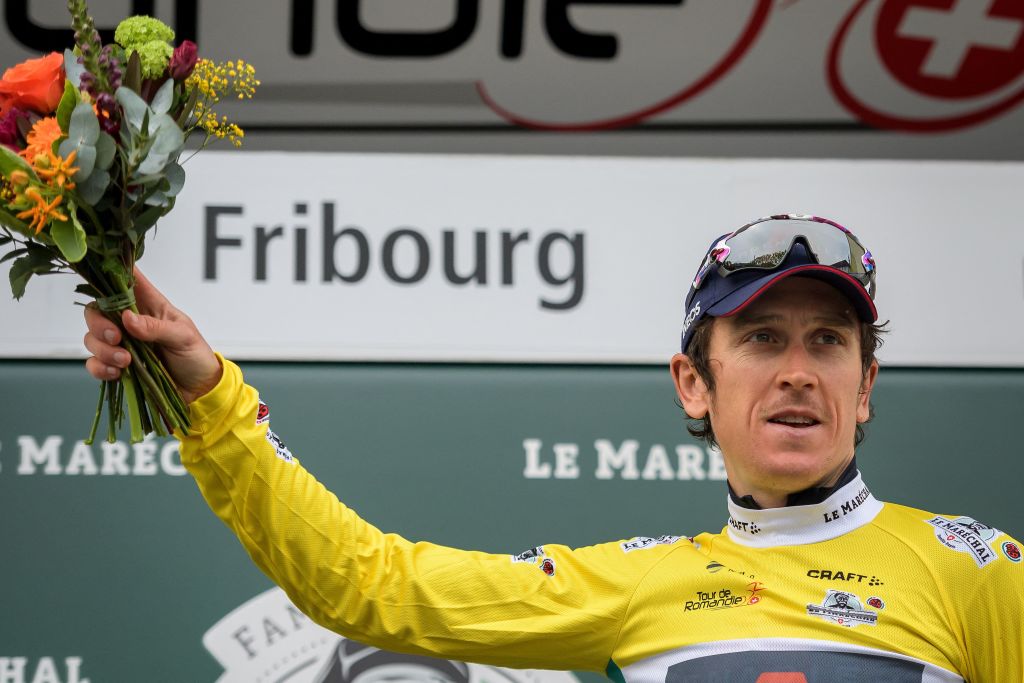
That’s the thing about Romandie. It was a race where the highs were so very high, where the victories of Woods and Soler and Colbrelli cemented these riders in their rightful places as contenders and yet, at the same time, the lows were so very, very low – Küng’s skid out in stage three, Thomas’s heartbreaking wreck in the final metres of stage four, Magnus Cort’s valiant attempt at glory that came to naught. Still, this was supposed to be a boring race. Ineos were supposed to control everything, just like they did on the first two stages, just as they did in Catalunya and even though they secured the first two spots on the podium, the race was always theirs to lose. For a while, it almost escaped them. Were it not for the time trial, it would have. However, the way Ineos rode – successfully or not – was a good thing.
Their early dominance, while it slowed down the battle for GC, enabled Colbrelli to make it to the end of stage three where he finally was able to claim his prize. Letting the race get away in the mountain stages made Thomas’ win that much more satisfying, more meaningful. It allowed other narratives to come to the fore, allowed countless others to try their hands at glory. And even though Thomas reigned victorious at the end, the story of how he did so will live on far longer than if he never crashed. Cycling is like that. It values almosts and not quites just as much as yes yes yesses. It is a sport of good stories, and in that vein, this was one hell of a ride.
Kate Wagner is a Chicago-based writer and critic. Her work on cycling can be found in various publications including Bicycling Magazine and ProCycling. Her newsletter, derailleur, is currently covering the Giro d'Italia in an unconventional, experimental fashion, featuring essays, short stories, multimedia works and illustration.
Kate Wagner is a Chicago-based writer and critic. Her work on cycling can be found in various publications including Procycling. Her newsletter covers cycling in an unconventional fashion, featuring essays, short stories, multimedia works and illustration.
She can be found Tweeting at @derailleurkate